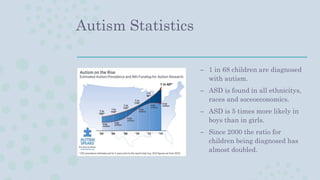Autism pp
- 2. Autism Statistics – 1 in 68 children are diagnosed with autism. – ASD is found in all ethnicitys, races and soceoeconomics. – ASD is 5 times more likely in boys than in girls. – Since 2000 the ratio for children being diagnosed has almost doubled.
- 3. What is Autism? Ausitm is: – A serious mental disorder. – Present from early childhood. – It impears the ability to communicate and interact. – Seperated into 4 categories. Autism dissorders:
- 4. Characterization Difficulties in: – Socail interaction – Verbal communication – Nonverbal communication – Repetative behaviors – Motor coordination Associated with: – Intellectual disabilities – Attention defecpt – Physical health issues – Accel in visual skills, music, math and art.
- 5. Early Signs of Autism What to look for from 6-12 months – Rarely smiles and no joyful expressions. – Rarely immitates sounds. – No back and fourth babbling. – No gestures to communicate. – Poor eye contact. – Rarely seeks attention. – Repetitively stiffens arms and legs. – Delay in motor development. – Delay in rolling over and crawling.
- 6. Screening and Diagnosis Two steps Developmental Screening – Consistis of a short test on basic skills and delays. – Children will be screened regularily at 9, 18 and 24 months. Comprehensive Diagnostic Evaluation – A thourough review of childs behavior and development. – Includes parental interview. – Here a child may be referred to a specialist. – Includes hearing/vision testing. – Includes genetic and neurological testing
- 7. Treatment Approaches in Schools – Physical therapy. – Occupational therapy. – Speech therapy. – Sensory therapy. – Dietary regemins. – Specialized teaching professionals. – Specialized programs. – IEP’s and goal changes.
- 8. IDEA – Individuals with Disabilities Education Act. – Free and appropriate education. – This means children have access to the best programs without worry for cost.







